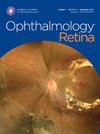Clinical Implications of Alternating Hypointense Bands on OCT Angiography in Retinal Vascular Occlusive Disease
IF 4.4
Q1 OPHTHALMOLOGY
引用次数: 0
Abstract
Purpose
To demonstrate the relationship between alternating hypointense signal bands on OCT angiography (OCTA), real-time fluorescein angiography (FA), and structural OCT findings in patients with retinal vascular occlusive disease (RVOD).
Design
Retrospective, consecutive case series.
Subjects
Consecutive patients with a clinical diagnosis of acute RVOD and alternating bands of hypointense OCTA flow signal on en face projections.
Methods
Complete ophthalmic examination and multimodal imaging, including color fundus photography, real-time FA, spectral-domain OCT, and OCTA performed with different instruments having different scan speeds and acquisition protocols.
Main Outcome Measures
The primary outcomes were: hypointense OCTA band characteristics (number, width, orientation, and location), OCTA acquisition characteristics (speed and scan direction), and FA findings including delayed arteriovenous (AV) transit and pulsatile flow. Secondary outcomes were: structural OCT changes including retinal fluid, paracentral acute middle maculopathy (PAMM) lesion, and a prominent middle limiting membrane (p-MLM) sign.
Results
OCT angiography hypointense bands were detected in the superficial and deep vascular plexuses in 9 eyes of 9 patients with either partial central retinal vein occlusion (RVO) or nonischemic RVO. When obtained on the same device, hypointense bands were thinner and more numerous at lower (100 kHz) scan speeds compared with higher (200 kHz) scan speeds. Band orientation was parallel to the OCTA scan direction, and their extent correlated with the area of delayed AV transit on FA. Structural OCT showed multiple PAMM lesions in 78% of cases and a p-MLM sign centered in the fovea in 44% of cases.
Conclusions
OCT hypointense bands are a novel biomarker in RVOD indicating delayed AV transit and pulsatile filling without the need for dye angiography. Structural OCT often shows PAMM in these eyes and, less commonly, a p-MLM sign.
Financial Disclosure(s)
Proprietary or commercial disclosure may be found in the Footnotes and Disclosures at the end of this article.
视网膜血管闭塞症患者 OCT 血管造影上的交替低密度带的临床意义。
目的:证明视网膜血管闭塞症(RVOD)患者的光学相干断层血管造影(OCTA)、实时荧光素血管造影(FA)和结构性OCT检查结果之间的交替低密度信号带之间的关系:设计:回顾性连续病例系列:临床诊断为急性视网膜血管闭塞症的连续患者,在面投影上交替出现低密度 OCTA 血流信号带:完整的眼科检查和多模态成像,包括彩色眼底照相(CFP)、实时FA、SD-OCT和OCTA,由不同的仪器以不同的扫描速度和采集协议进行:主要结果测量:主要结果为低密度 OCTA 波段特征(数量、宽度、方向和位置)、OCTA 采集特征(速度和扫描方向)、FA 结果(包括延迟的动静脉(AV)通过和搏动性血流)。次要结果包括结构性 OCT 变化,包括视网膜积液、旁中心急性黄斑病变(PAMM)和突出中缘膜(p-MLM)征象:结果:9 位部分 CRAO 或非缺血性 RVO 患者的 9 只眼睛的浅层和深层血管丛中都检测到了 OCTA 高密度带。在同一设备上获得的低密度条带,扫描速度较低(100 kHz)时比扫描速度较高(200 kHz)时更细、更多。低密度带的方向与 OCTA 扫描方向平行,其范围与 FA 上延迟房室传导的区域相关。结构性OCT显示78%的病例存在多个PAMM病变,44%的病例存在以眼窝为中心的p-MLM征象:结论:OCTA高密度带是RVOD的一种新型生物标志物,可显示房室转流延迟和搏动性充盈,无需进行染色血管造影。结构性 OCT 常常在这些眼球中显示 PAMM,较少见的是 p-MLM 征。
本文章由计算机程序翻译,如有差异,请以英文原文为准。
求助全文
约1分钟内获得全文
求助全文

 求助内容:
求助内容: 应助结果提醒方式:
应助结果提醒方式:


